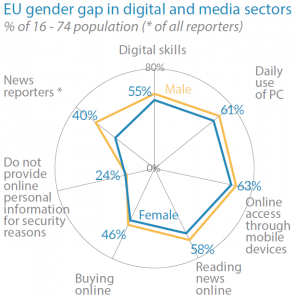The need to ensure digital inclusion, and tackle gender stereotyping and other barriers to access, skills, representation and safety affecting women and girls has been recognised globally in the Sustainable Development Goals, and within the EU’s Digital Single Market Strategy, together with the need for better data to inform action. The existing data point to a global digital gender divide. Within the EU, this is not so much a question of women and girls lacking basic internet access or skills – although there are gender differences, and the number of women who have never used the internet remains significant (14 % of women compared to 12 % of men). The gender gaps are much wider in advanced IT skills, tertiary education, employment and decision-making in the digital sector, with girls and women less likely to continue studying science and technology beyond the age of 15, enter or continue a career in ICT, reach specialist and managerial levels or start their own tech companies. Research highlights that children’s perceptions of their own abilities and career aspirations are shaped early, and strongly influenced by attitudes and expectations in families, peer groups, schools, and wider society – including limiting or positive images, messages and role models conveyed by traditional and new media. Media monitoring shows that there has been some progress, but women continue to be under-represented as reporters and decision-makers and misrepresented in coverage across the news media as well as in film and other sectors.
EU gender gap in digital and media sectors
Categories:
Related Articles
Visit the European Parliament page on
Visit the European Parliament page on
We write about
RSS Link to Scientific Foresight (STOA)
RSS Link to Members’ Research Service
Blogroll
Disclaimer and Copyright statement
The content of all documents (and articles) contained in this blog is the sole responsibility of the author and any opinions expressed therein do not necessarily represent the official position of the European Parliament. It is addressed to the Members and staff of the EP for their parliamentary work. Reproduction and translation for non-commercial purposes are authorised, provided the source is acknowledged and the European Parliament is given prior notice and sent a copy.
For a comprehensive description of our cookie and data protection policies, please visit Terms and Conditions page.
Copyright © European Union, 2014-2019. All rights reserved.








Be the first to write a comment.